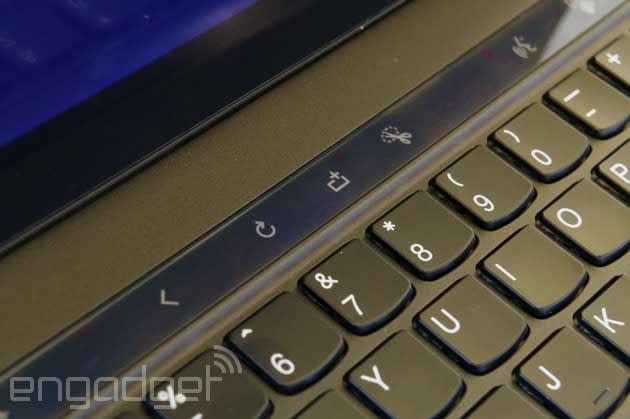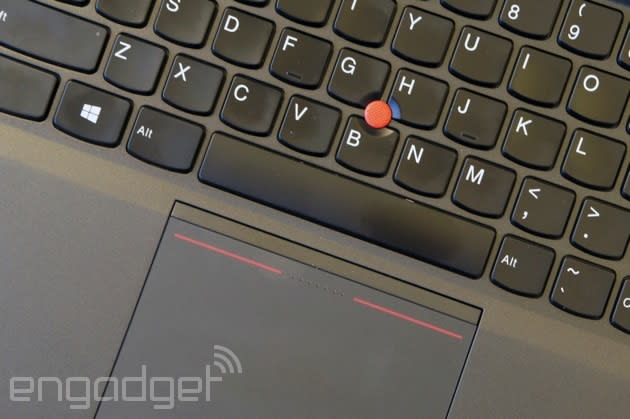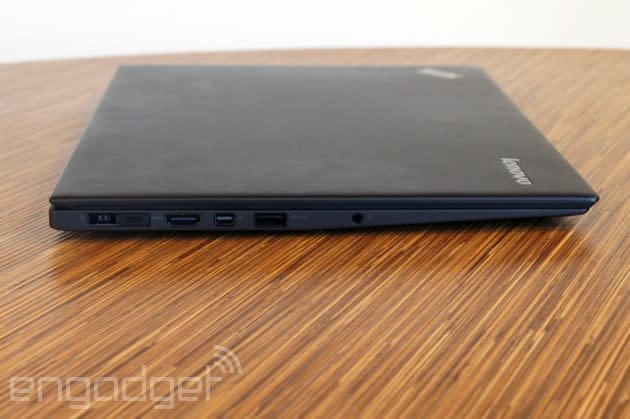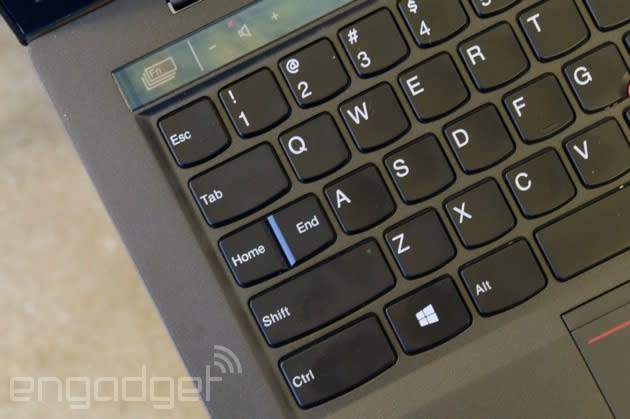Lenovo ThinkPad X1 Carbon review (2014): new, but not necessarily improved

Don't call it a business laptop. I mean, you could, but you'd be missing the point: Though the original Lenovo ThinkPad X1 Carbon was technically aimed at corporate users, it was good enough for us to recommend even to regular consumers. That was a year and a half ago, though: In the intervening months, the machine has gone without an update, save for the addition of an optional touchscreen. Finally, though, Lenovo went and refreshed it, bringing it into the modern age with fresh processors, a thinner and lighter design and an ultra-high-res 2,560 x 1,440 screen option. In addition to tweaking the original, though, Lenovo also overhauled the keyboard, adding an "adaptive panel" whose shortcuts change depending on what app you're using (yes, that means the traditional Fn buttons are out). That potentially controversial change aside, this clearly has the makings of another winner... right?
Look and feel
With the exception of that adaptive keyboard panel, which I'll get to in a moment, Lenovo didn't reinvent the wheel with the new X1 Carbon. It just made that wheel even thinner and lighter than it was before. Once again, the X1 claims to be the lightest 14-inch Ultrabook on the market, with a weight of 3.15 pounds and measuring 0.72 inch thick (if for some reason you configure the machine without a touchscreen, it'll come out to 2.8 pounds and 0.69 inch thick). That's a marginal improvement over last year's model, which came in at 3.25 pounds and 0.81 inch thick (make that 2.99 pounds/0.74 inch for the non-touch version). Numbers aside, then, this is more of a revision than a full-on makeover. Nonetheless, it's still kinda neat that the new touchscreen model is now thinner than the original non-touch one.
One thing that hasn't changed: the build quality. As ever, the notebook was built to meet the military's MIL-STD-810G standards for toughness, with an unwavering hinge that can extend 180 degrees without breaking. Even that new adaptive keyboard is coated in Gorilla Glass, to help ward off unsightly scratches. Once again, the lid here is fashioned out of carbon fiber, though the chassis is now made from magnesium alloy. That change aside, this otherwise looks like a ThinkPad, and to a Lenovo die-hard, it's a beautiful thing indeed. ThinkPad loyalists will love it for its clean lines, cushy keyboard and signature red TrackPoint, even if the shape is, as ever, a little boxy. Even if you're a fresh convert to the brand, though, the craftsmanship is something to be admired. As plain as that monotone black casing might look, it's still doing a good job of masking fingerprints, even now that I've been using it for several weeks. And scratches? Haven't picked up a single one yet.

Pick up the laptop, and you'll find all the ports on the right and left sides, with nothing around back except for a sealed SIM card tray. Over on the right, there's a Gigabit Ethernet port (adapter required), along with a USB 3.0 port. On the left, there's Lenovo's unique OneLink power connector, a full-sized HDMI socket, a Mini DisplayPort, a headphone jack and a second USB 3.0 socket (last time, only one of the USB connections was 3.0). Weirdly, though, Lenovo chose to nix the SD card slot that came in the last-gen model. A shame -- we thought we were past the point where Ultrabook makers pretended they couldn't fit a memory card reader on their super-skinny machines.
As before, the X1 Carbon comes standard with a 14-inch, 1,600 x 900 panel, but whereas that used to be the only resolution option, you can now opt for a higher-res 2,560 x 1,440 panel instead. Either way, the screen has a low-glare (not-quite-matte) finish that barely reflects any light, at least not in your typical fluorescent office. Colors are good, and the viewing angles are wide -- you'll have no problem reading the screen from off to the side or with the lid dipped forward. If anything, the only flaw has to do with the fact that not enough apps are optimized for that 2,560 x 1,440 resolution -- Google Chrome looks awful, for example -- but then again, we've said the same thing about every other notebook with a higher-than-full-HD display, including the Retina display MacBook Pro.
Keyboard and trackpad

You have to hand it to Lenovo: It takes cojones chutzpah to mess around with the ThinkPad keyboard. You know, the very thing that has kept loyal fans coming back generation after generation. And yet, Lenovo has revised the keyboard a couple times now, first moving to an island-style layout, and now doing away with the physical Function buttons. What used to be a six-row keyboard is now a five-row setup, with an adaptive panel taking the place of the Fn keys.
By default, the panel shows multimedia controls -- things like volume up and down, brightness and Windows 8-specific functions like search and pulling up the app menu. There are also shortcuts for Dragon Assistant (more on that later), the Windows Snipping tool and a programmable "cloud" hotkey that takes you to OneDrive or Lenovo Reach, by default.
If you go into the keyboard settings -- also accessible from that default panel screen -- you can select a different cloud application, as well as change the order of the various adaptive keyboard "modes." Further, you can make it so that the "default" screen isn't actually the default at all -- if you'd rather see web browser buttons, video-conferencing tools or the traditional Fn buttons, you absolutely can. By default, the keyboard is set up so that the controls change depending on what program you're using -- a useful feature, we'd say. However, if you live and die by Fn shortcuts, you might wanna make sure they're always visible. It's your best bet now that the physical keys are no more. Even then, you can press a button at any time to cycle through the different modes.
All told, the adaptive panel feels like a good idea -- and a well-executed one, at that. Still, the move from a six-row keyboard to a five-row one meant Lenovo had to shuffle around some key buttons, or even remove them altogether. And you know what they say about change, right? It's damn confusing. It's less obvious, for instance, how to take a screenshot with no PrtSc button. There's also no Caps Lock button this time around; you'll need to hit Shift twice instead (aren't you glad you have us to explain these things?).
Worse, Lenovo shrunk the Backspace key and switched places with the Delete key, so that the Delete key is now in the upper-right corner, where the Backspace button usually is. So, depending on the size of your hands, you might find yourself missing the Backspace key, striking the Delete key instead. All in all, it's still a fine keyboard, with springy buttons, ample travel and a sturdy underlying panel. We just can't promise all of you will get used to that shrunken Backspace key.

Wrapping up, this isn't the first time we've seen a ThinkPad touchpad with zero buttons -- but it's a first for the X1 Carbon, anyway. As always, the trackpad has integrated right and left buttons, but now there are also built-in touch zones to go with the TrackPoint. So, if you've got your finger on the red stick and want to click right or left, or do a quick-scroll down the page, you'll need to feel around and make sure your finger hits the appropriate strike zone.
Truly, it's not that hard, but I can see where it'd be an adjustment for folks upgrading from, say, an old T-series model. For one thing, the right and left TrackPoint buttons are both underlined in red, so you can't miss them. Secondly, the scroll zone is marked by a row of raised dots, so it's easy to find by sight and by feel. Most importantly, perhaps, Lenovo has done some fine-tuning so that there's no longer a "dead zone" between touch areas. That said -- and I know I've hinted at this already -- this will be an easier transition for folks who are fairly new to the ThinkPad line.
Performance
PCMark7 | 3DMark06 | 3DMark11 | ATTO (top disk speeds) | |
|---|---|---|---|---|
Lenovo ThinkPad X1 Carbon (2014, 1.6GHz Core i5-4200U, Intel HD 4400) | 4,773 | 5,881 | E1,727 / P930 / X284 | 555 MB/s (reads); 137 MB/s (writes) |
HP Spectre 13 Ultrabook (1.6GHz Core i5-4200U, Intel HD 4400) | 4,786 | 6,005 | E1,837 / P962 / X293 | 527 MB/s (reads); 327 MB/s (writes) |
Lenovo IdeaPad Yoga 2 Pro (1.6GHz Core i5-4200U, Intel HD 4400) | 4,676 | 5,688 | E1,713 / P914 / X281 | 546 MB/s (reads); 139 MB/s (writes) |
Samsung ATIV Book 9 Lite (1.4GHz "quad-core" processor, AMD Radeon HD 8250) | 2,060 | 2,814 | E749 / P530 | 550 MB/s (reads); 139 MB/s (writes) |
Samsung ATIV Book 9 Plus (1.6GHz Core i5-4200U, Intel HD 4400) | 4,973 | 5,611 | E1,675 / P867 / X277 | 547 MB/s (reads); 508 MB/s (writes) |
Acer Aspire S7-392 (1.6GHz Intel Core i5-4200U, Intel HD 4400) | 5,108 | 5,158 | E1,724 / P952 / X298 | 975 MB/s (reads); 1.1 GB/s (writes) |
Sony VAIO Pro 13 (1.6GHz Intel Core i5-4200U, Intel HD 4400) | 4,502 | 4,413 | E1,177 / P636 / X203 | 1.04 GB/s (reads); 479 MB/s (writes) |
Sony VAIO Duo 13 (1.6GHz Core i5-4200U, Intel HD 4400) | 4,440 | 6,047 | E1,853 / P975 / X297 | 546 MB/s (reads); 139 MB/s (writes) |
Sony VAIO Pro 11 (1.8GHz Core i7-4500U, Intel HD 4400) | 4,634 | N/A | E1,067 / P600 / X183 | 558 MB/s (reads); 255 MB/s (writes) |
The better laptop components get, the tougher it is to evaluate performance. I mean, is there really such a thing as "bad" performance these days, when even the most sluggish of Ultrabooks can cold-boot in 10 seconds or less? Maybe not, but there's still an argument to be made that some models offer more speed for the money. As far as the new X1 Carbon goes, you're looking at about the same benchmark results as other laptops with Intel's dual-core Core i5-4200U processor. The weird thing is, even with 8GB of RAM, it merely matches some competitors that use half the memory. In fact, it actually trails those machines in some cases. Take the HP Spectre 13, for instance; it bests the X1 nearly every time, and costs about $300 less (and that's even with the high-res screen option).
In absolute terms, though, the X1 is a good performer. Boot-up takes nine seconds, and the Samsung-made SSD reaches top write speeds of 555 megabytes per second, which is on the higher end of normal for machines that don't have a faster PCI Express drive. (Read speeds top out around 137 MB/s, which is less impressive; the Spectre 13 makes it all the way up to 327 MB/s.) Meanwhile, our own Terrence O'Brien, who owns the 8GB configuration, says Photoshop runs well for him, even when he's applying effects to large images. He's also had no problem juggling Photoshop with other apps like HipChat and Chrome, complete with 17 open tabs. Through it all, he had no problem streaming a Mets game, sharing tabs in Chromecast or watching Aereo casted to his TV. The only sign that 8GB and a Haswell processor might not be enough: Adobe Premiere is still a bit slow to load, he says.
Battery life | |
|---|---|
Lenovo ThinkPad X1 Carbon (2014) | 6:18 |
MacBook Air (13-inch, 2013) | 12:51 |
MacBook Pro with Retina display (13-inch, 2013) | 11:18 |
Sony VAIO Duo 13 | 9:40 |
Samsung ATIV Book 9 Plus | 8:44 |
HP Spectre 13 | 8:30 |
Sony VAIO Pro 13 | 8:24 |
Lenovo IdeaPad U430 Touch | 7:53 |
Acer Aspire S7-392 | 7:33 |
Acer Iconia W700 | 7:13 |
Sony VAIO Pro 11 | 6:41 |
Lenovo IdeaPad Yoga 2 Pro | 6:32 |
Microsoft Surface Pro 2 | 6:27 |
Lenovo IdeaPad Yoga 13 | 5:32 |
Lenovo ThinkPad X1 Carbon (2013) | 5:07 |
Lenovo ThinkPad X1 Carbon Touch (2013) | 5:00 |
Samsung ATIV Book 9 Lite | 4:33 |
Typically, when Lenovo reps say a laptop lasts X number of hours, we're inclined to believe them. After all, Lenovo's product managers have been known to use Engadget's own video looping test in their labs, so it's not unusual for them to come up with a number that's similar to ours. In the case of the new X1 Carbon, though, the real-world battery life falls far short of Lenovo's claims. In particular, the company is promising up to 8.6 hours of runtime, but we managed just six hours and 18 minutes -- the worst showing for any Haswell Ultrabook we've tested.
Granted, the last-gen X1 Carbon got around five hours, which means this year's model delivers more than a 20 percent improvement -- not an insignificant difference. Also, the X1 Carbon uses a quick-charging technology that allows it to rebound to 80 percent capacity in under an hour. Still, all that said, a six-hour runtime is pretty disappointing when other skinny machines can last seven, eight, nine (even 13) hours on a charge.
Software and warranty

We normally give the software section in laptop reviews fairly short shrift, reporting back on all the bundled apps and how annoying some of them are. In this case, though, we'll go into a little more detail, as the X1 Carbon comes with an app we haven't used yet: Nuance's Dragon Assistant, the latest version of which was unveiled just a couple months ago. In brief, it's a desktop app that you can use to dictate emails and documents, search the web, control playlists, turn the computer on and off, adjust system settings and post to social media sites like Twitter and Facebook. In particular, version 3.0 is more conversational than previous iterations, so that if you ask, say, "Who wrote Her?" you can follow up with phrases like "What else did he write?" (And by "he," of course, I mean Spike Jonze, but I trust Dragon is smart enough to tell you that.)
For now, at least, the only supported language is English, though you have some choices when it comes to calibrating your voice: You can tell the app you don't have a strong accent, or that you speak with a Chinese or Indian accent (everybody else can select the "other accents" option). You can personalize the experience even further by specifying your gender, but you don't have to. In my tests, the program pronounced my name correctly on the first try (plenty of people call me "Dawn" or "Donna"), and it fared just fine with my male colleagues too. I also aced the initial sound test: The program measures your levels in the setup process, but I found even without any fine-tuning, I had no problem getting into the optimal volume range.

With the exception of Norton Internet Security, which goes a little overboard with the subscription-renewal pop-ups, the software load here is fairly minimal. In addition to that security trial, you get "Metro" versions of Skitch Touch, Evernote Touch, AccuWeather.com, Amazon's Kindle reader, Hightail (formerly YouSendIt), Zinio's magazine store and the music-streaming service rara.com. Meanwhile, Lenovo threw in some apps of its own, including Lenovo Settings and Lenovo Support (they are what they sound like) and Reach, which is a cloud service.
As for warranty service, the ThinkPad X1 Carbon starts with one year of coverage, though you can extend it to up to four if you like. Starting with that optional second year of service, you can also add accidental damage protection as well as on-site service (by default, you have to send it in to a depot).
Configuration options
The new ThinkPad X1 Carbon starts at $1,259 with a Core i5 processor, 4GB of RAM, a 128GB SSD and a 1080p display. If you want that super-sharp 2,560 x 1,440 panel, the starting price is $1,359. It's important to note, too, that the $1,259 model actually comes with a non-touch panel. If you do want a touchscreen -- and don't we all at this point? -- you'll have to pay an extra $150. Ouch.
Aside from the higher-res display option, you can also opt for a slightly faster Core i5 processor than the one that comes standard (that'll cost you an extra $100). There's also a Core i7 CPU available for an extra $270. Additionally, you can go up to 8GB of RAM ($130) or get up to 512GB of storage (premium SSD options start at $100, but go up to $450 in the case of the 512GB drive).
The competition
If it sounds like I'm holding the X1 Carbon to a high standard (and I am), it's because it has tons of competition. Even if you decided you didn't want a convertible machine like the Dell XPS 12 ($1,000 and up) or Lenovo's own Yoga 2 Pro ($999-plus), you'd have a tough choice among just the traditional clamshell-style Ultrabooks. At the moment, our favorites include the Samsung ATIV Book 9 Plus ($1,400 and up) and Acer Aspire S7-392 ($1,350-plus), both of which can be had with super-high-res displays, similar to the X1 Carbon's. Also, the HP Spectre 13 is a pretty good deal considering the relatively low thousand-dollar starting price. Generally speaking, the X1 Carbon has a better keyboard and trackpad than most, with a more durable (it not necessarily prettier) design. On the other hand, the performance and display are merely on par with the competition, whereas the battery life is worst-in-class.
Wrap-up

On paper, the new X1 Carbon is an improvement over the original (which we liked!) in nearly every respect: It's thinner and lighter, and has a sharper screen, fresh processors and longer battery life. The problem is, the X1 Carbon, like many things in life, isn't just the sum of its parts -- it's actually slightly less than that. The adaptive keyboard panel, though useful, comes at the expense of an unfamiliar layout, and for some, those context-aware function keys won't even be worth it. With this redesign, the X1 Carbon has also lost its SD reader -- not a dealbreaker, per se, but an annoyance for many. Worse, though the battery life is indeed longer than it used to be, it trails the competition by a wide margin, making it the shortest-lasting laptop in its class. Finally, this thing is expensive: even with a starting price of $1,259, the touchscreen still costs $150 extra.
If you're a ThinkPad die-hard, you might still consider the X1 Carbon for its durable build and (mostly) satisfying keyboard. But for everybody else -- folks who are indifferent to the Lenovo brand --it's tough to get excited about this when there are so many other well-rounded options to choose from.
Terrence O'Brien, Edgar Alvarez and Daniel Orren contributed to this review.


























